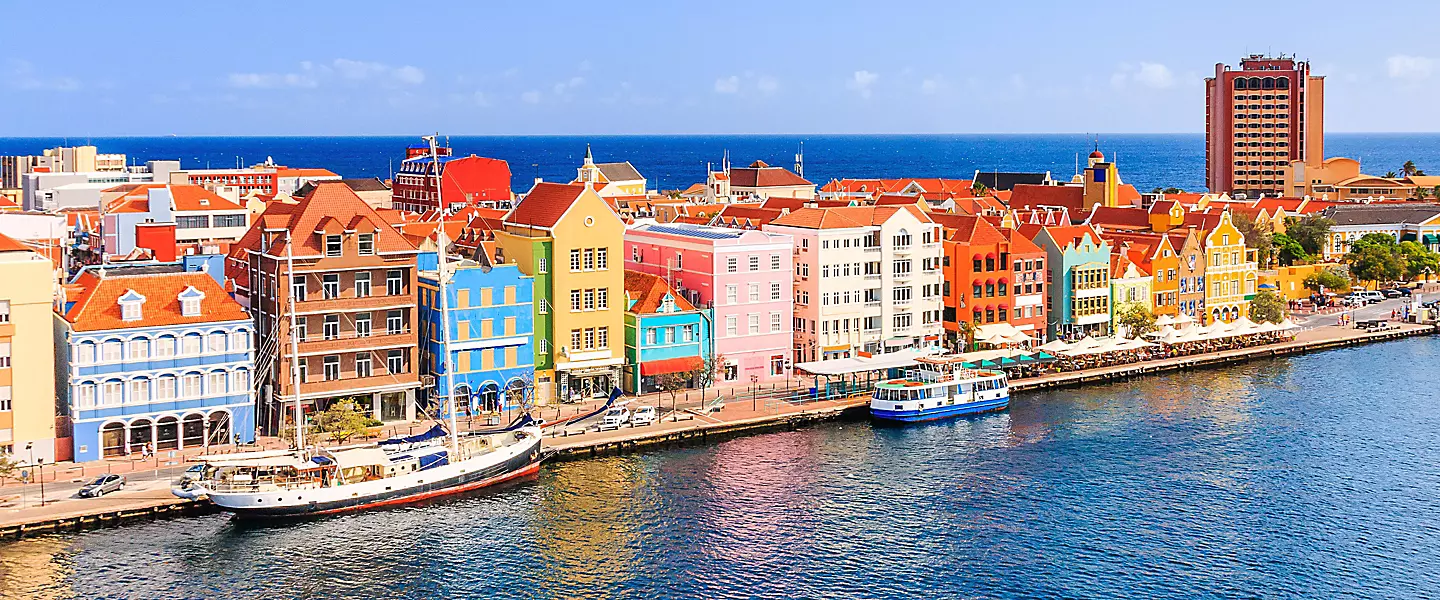
CURACAO
Explore CURACAO
CURACAO
Curaçao: A Colorful Caribbean Escape
Curaçao is a vibrant island paradise known for its turquoise waters, colorful Dutch colonial architecture, and incredible diving spots. Located in the southern Caribbean, outside the hurricane belt, Curaçao offers a perfect blend of adventure, relaxation, and rich cultural heritage. Whether you're exploring Willemstad’s historic streets, snorkeling in crystal-clear waters, or indulging in local cuisine, Curaçao is a must-visit destination for beach lovers, culture seekers, and water sports enthusiasts alike.
Frequently Asked Questions: Curaçao
Curaçao enjoys warm, sunny weather year-round, but some seasons are better for certain activities:
- December–April (Peak Season): Best for dry weather, festivals, and lively beach clubs.
- May–August (Shoulder Season): Ideal for fewer crowds and great hotel deals.
- September–November (Low Season): Great for budget travelers, but expect occasional rain showers.
- Willemstad – The UNESCO-listed capital, famous for its colorful Dutch-inspired buildings and floating Queen Emma Bridge.
- Klein Curaçao – A tiny uninhabited island with powdery white sand and pristine waters.
- Playa Kenepa (Grote Knip) – One of Curaçao’s most stunning beaches, perfect for swimming and snorkeling.
- Blue Room Cave – A hidden underwater cave with glowing blue waters.
- Shete Boka National Park – A rugged coastal park with dramatic waves and sea turtle nesting sites.
- Christoffel National Park – Home to the island’s highest peak and scenic hiking trails.
- Mambo Beach Boulevard – A lively strip of beach clubs, restaurants, and nightlife.
- Curacao Sea Aquarium & Dolphin Academy – A family-friendly marine attraction with interactive dolphin encounters.
- Tugboat Wreck Dive Site – One of Curaçao’s best snorkeling and dive spots.
- Hato Caves – A network of limestone caves with stalactites, stalagmites, and ancient petroglyphs.
- Keshi Yena – A traditional dish made of cheese stuffed with spiced meat and vegetables.
- Bitterballen – A Dutch-style deep-fried meatball snack.
- Pastechi – A savory pastry filled with cheese, meat, or seafood.
- Kabritu Stoba – A rich, slow-cooked goat stew.
- Funchi & Tutu – Cornmeal-based side dishes similar to polenta, often served with seafood.
- Lionfish – A delicious and eco-friendly seafood option.
- Iguana Stew – A local delicacy found in traditional eateries.
- Poffertjes – Mini Dutch pancakes dusted with powdered sugar.
- Blue Curaçao Liqueur – The island’s signature citrus-flavored liqueur.
- Rum Punch & Awa di Lamunchi – A refreshing lime-infused drink, perfect for hot days.
- Flights: Arrive at Curaçao International Airport (CUR).
- Car Rentals: Recommended for exploring beaches, national parks, and remote areas.
- Taxis: Available but can be expensive—fares are fixed, so confirm before riding.
- Public Buses (Konvoi): Budget-friendly but limited in routes and schedules.
- Scooter & Bike Rentals: Great for exploring Willemstad and nearby beaches.
- Water Taxis: The best way to reach Klein Curaçao and secluded coves.
- For U.S. travelers: No visa required for stays up to 90 days, but a valid passport is necessary.
- For international travelers: Check Curaçao’s visa requirements based on your nationality.
- Digital Immigration Card: Required for entry—complete online before arrival.
- Currency: Netherlands Antillean Guilder (ANG), but U.S. dollars (USD) are widely accepted.
- Credit cards are widely accepted, but bring cash for local markets and small vendors.
- ATMs are available throughout the island, dispensing both guilders and U.S. dollars.
- Currency exchange is available at the airport and banks.
- Papiamento, Dutch, English, and Spanish are widely spoken.
- Most locals speak English fluently, especially in tourist areas.
- Curaçaoans are friendly and polite—greet people with a “Bon dia” (Good morning).
- Tipping is appreciated (10-15% at restaurants, $1-2 per drink at bars).
- Casual beachwear is fine for resorts, but cover up when visiting town or dining out.
- Respect the marine environment—Curaçao has strict reef conservation laws.
- The island follows European-style service—dining is leisurely, so don’t rush meals.
- Restaurants: 10–15% tip is standard, but some places include a service charge.
- Bars: $1–2 per drink or 10–15% of the total bill.
- Hotels: $2–5 per bag for bellhops, $2–5 per night for housekeeping.
- Taxis: Tipping is expected, usually around 10% of the fare.
- Tour Guides & Excursions: $10–20 per person for excellent service.
- For peak travel season (December–April): Book 6–12 months in advance for hotels and flights.
- For off-season travel (May–November): Booking a few weeks ahead is usually fine.
- For Klein Curaçao tours and diving trips: Book at least a few weeks in advance.
- No COVID-19 test is required for entry, but check for updates before traveling.
- Some beaches have entrance fees—bring small cash for access.
- Sunscreen with oxybenzone is banned—use reef-safe sunscreen to protect the coral reefs.
Contact us at 281-229-0862 or admin@pointmetoparadise.com
